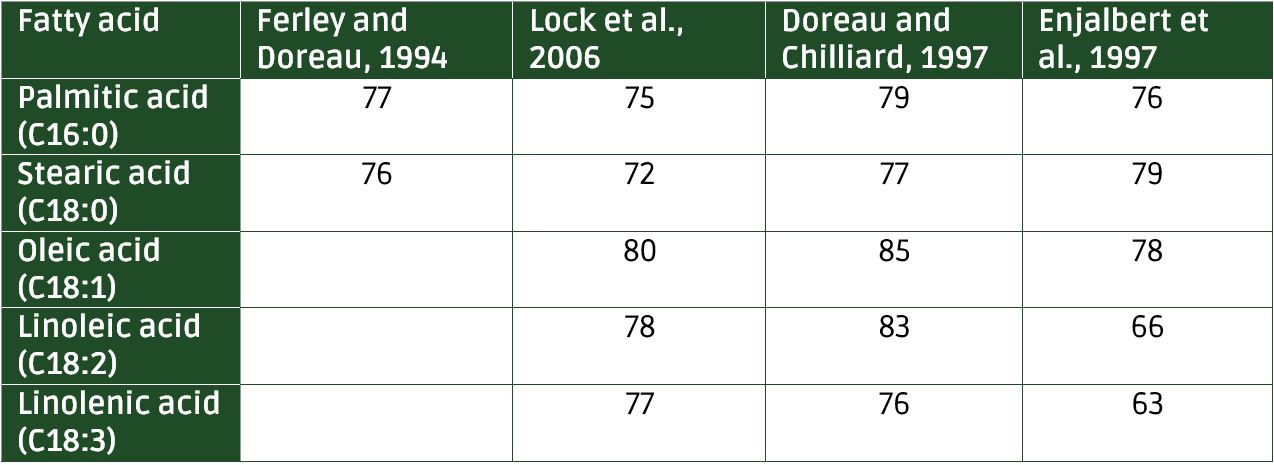Palmitic and stearic acid are both easily digestible!
Due to the increasing milk yield of dairy cows, the energetic supplementation of feed rations is becoming more and more important. The optimal solution is the use of rumen-stable fats. In contrast to the use of high amounts of starch, the use of rumen-stable fats avoids rumen-acidosis. Rumen-stable fats are primarily based on palm oil or rapeseed oil. The dominant fatty acids are palmitic acid (C16:0), stearic acid (C18:0) and, in smaller amounts, oleic acid (C18:1).
To be able to evaluate the fatty acids, the ratio of the fatty acid in the feed, as well as in the digestive tract, must be taken into account.
Absorption of different fatty acids
In the early 1990s, it was found that stearic acid (C18:0) is the only fatty acid that passes from the rumen into the small intestine in significantly higher as the amount in feed. This became particularly clear with an addition of Ca-soap or a fat mixture with higher proportions of oleic acid (C18:1) (Wu et al., 1991).
The table shows the fatty acid intake and flow from the rumen in cows on a ration with 40% concentration of compound feed.

The amounts of stearic acid entering the small intestine from the rumen were significantly higher in all rations compared to inkate via feed. At the same time, the higher amounts of oleic acid in the supplement groups were converted to stearic acid in the rumen. Thus they no longer entered the small intestine.
In all groups, stearic acid (C18:0) was the fatty acid with the largest proportion of the total fatty acids that enter the small intestine. There they are available for absorption.
Biohydrogenation
Unsaturated fatty acids such as oleic acid (C18:1) are very quickly “biohydrogenated” in the rumen. This means that their double bonds are saturated so that the oleic acid is converted to stearic acid. At the same time, the test results prove that Ca-soaps or also the fat mixture with higher proportions of oleic acid used by Wu et al. were not rumen-stable at all. Despite the fact that they were declared as such.
Higher amounts of unsaturated fatty acids in the feed have additional negative effects on the rumen microbes. This is often shown by reduced feed intake and decreasing milk fat content. A comprehensive review by Allen (2000) does confirm this.
Digestibility of long-chain fatty acids
Previous studies to assess the digestibility of fatty acids were based on measuring the difference between feed intake and secretion in faeces. These studies didn’t consider the conversion of fatty acids in the rumen. The conclusions were that palmitic acid was more digestible than stearic acid. However, these statements were made before studies with animals made the extent of fat conversion in the rumen measurable. Now we know, a significant increase in stearic acid (C18:0) occurs in the rumen before it enters the small intestine. As a result, the digestibility of stearic acid (C18:0) has been massively underestimated. Especially when only considering intake via feed and excretion via faeces.
The table shows the average digestibility of long-chain fatty acids in dairy cows, assembled from several review articles.

Palmitic acid (C16:0) and stearic acid (C18:0) are therefore almost equally digestible.
Differences in digestibility
All the authors mentioned conclude that differences in individual studies are primarily due to individual study conditions. Glasser et al. (2008) found a slight decrease in the apparent absorption rate of stearic acid (C18:0) at very high flow rates (C18:0) (>50 g/kg DM intake). The causes of this are unknown but are associated with the adaptive mechanisms of the cow. These serve to maintain the milk fat composition.
Even with a slight decrease in the absorption rate of stearic acid (C18:0) at very high flow rates, this has little significance. The majority of the fatty acids present in the small intestine is stearic acid. Thus, the absorbed amount of stearic acid (C18:0) exceeds that of all other fatty acids by far.
The authors agree that differences in the digestibility of individual fatty acids contribute little to differences in the digestibility of fats in the feed. Other causes, such as particle size distribution and other parameters, probably have much greater influence.
There are therefore no systematic differences in the digestibility of palmitic acid (C16:0) and stearic acid (C18:0).